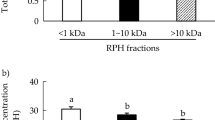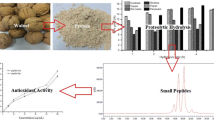Abstract
Wheat germ protein hydrolysates were prepared by protease hydrolysis, ultrafiltration and dynamical adsorption of resin. The total amount of amino acids in 100 g wheat germ protein hydrolysates is 93.95 g. Wheat germ protein hydrolysates are primarily composed of 4 fractions: 17.78% in the relative molecular mass range of 11 563–1 512, 17.50% in 1512 – 842, 27.38% in 842 – 372 and 30.65% in 372 – 76, respectively. The antioxidant properties of wheat germ protein hydrolysates were evaluated by using different antioxidant tests in vitro. 1.20 g/L wheat germ protein hydrolysates exhibit 78.75% inhibition of peroxidation in linolei acid system; and 1.6 g/L wheat germ protein hydrolysates show 81.11% scavenging effect on the 1,1-diphenyl-2-picrylhrazyl radical. The reducing power of 2.50 g/L wheat germ protein hydrolysates is 0.84. Furthermore, the scavenging activity of 0.60 g/L wheat germ protein hydrolysates against superoxide radical is 75.40%; 0.50 g/L wheat germ protein hydrolysates exhibit 63.35% chelating effect on ferrous ion. These antioxidant activities of wheat germ protein hydrolsates increase with the increase of its concentration. Experimental results suggest that wheat germ protein hydrolysate is a suitable natural antioxidant rich in nutrition and nontoxic.
Similar content being viewed by others
References
Debashis D D, Bhattacharjee B M, Banerjee R K. Hydroxyl radicals is the major causative factor in stress-induced gastric ulceration [J]. Free Radical Biology and Medicine, 1997, 23(1): 8–18.
Sussman M S, Bulkley G B. Oxygen-derived free radicals in reperfusion injury[J]. Methods in Enzymology, 1990, 186: 711–723.
Bergendi L, Durackova Z, Ferencik M. Chemistry, physiology and pathology of free radicals [J]. Life Sciences, 1999, 65(18–19): 1865–1874.
Ito N, Hirose M, Fukushima H, et al. Studies on antioxidants: their carcinogenic and modifying effects on chemical carcinogens[J]. Food and Chemical Toxicology, 1986, 24(10–11): 1071–1092.
Stich H F. The beneficial and hazardous effects of simple phenolic compounds [J]. Mutation Research, 1991, 259(3–4): 307–324.
Yamaguchi N, Naito S, Yokoo Y, et al. Use of protein hydrolysates as antioxidants in biscuits [J]. Journal of the Japanese Society for Food Science and Technology, 1980, 27(2): 56–59.
Pratt D E. Water soluble antioxidant activity in soyabeans[J]. Journal of Food Science, 1972, 37(2): 322–323.
Rhee K S, Ziprin Y A, Rhee K C K. Water-soluble antioxidant activity of oilseed protein derivatives in model lipid peroxidation systems of meat [J]. Journal of Food Science, 1979, 44(4): 1132–1135.
Park P J, Jung W K, Nam K S, et al. Purification and characterization of antioxidative peptides from protein hydrolysate of lecithin-free egg yolk[J]. Journal of the American Oil Chemists and Society, 2001, 78(6): 651–656.
Carlsen C U, Rasmussen K T, Kjeldsen K K, et al. Pro-and antioxidative activity of protein fractions from pork (longissimus dorsi) [J]. European Food Research and Technology, 2003, 217(3): 195–200.
Drail J, Bannier E, Chazot C, et al. Oxidants and antioxidants in long-term haemodialysis patients [J]. IL Farmaco, 2001, 56(5–7): 463–465.
Gutierrez M A, Mitsuya T, Hatta H, et al. Comparison of egg-yolk protein hydrolysate and soyabean protein hydrolysate in terms of nitrogen utilization [J]. British Journal of Nutrition, 1998, 80(5): 477–484.
Yen G C, Hsieh C L. Antioxidant activity of extracts from Du-zhong (Eucommia ulmoides) toward various peroxidation models in vitro [J]. Journal of Agricultural and Food Chemistry, 1998, 46(10): 3952–3957.
Yen G C, Chen H Y. Antioxidant activity of various tea extracts in relation to their antimutagenicity [J]. Journal of Agricultural and Food Chemistry, 1995, 43(1): 27–32.
Shimada K, Fujikawa K, Yahara K, et al. Antioxidative properties of xanthum on the autoxidation of soyabean oil in cyclodextrin emulsion [J]. Journal of Agricultural and Food Chemistry, 1992, 40(6): 945–948.
Yu W, Zhao Y, Xue Z, et al. The antioxidant properties of lycopene concentrate extracted from tomato paste [J]. Journal of the American Oil Chemists Society, 2001, 78(7): 697–701.
Decker E A, Welch B. Role of ferritin as a lipid oxidation catalyst in muscle food [J]. Journal of Agricultural and Food Chemistry, 1990, 38 (3): 674–677.
Eresha M, Niranjan R, Hee-Guk B, et al. Investigation of jumbo squid (Dosidicus gigas) skin gelatin peptides for their in vitro antioxidant effects [J]. Life Sciences, 2005, 77(17): 2166–2178.
Dorman H J D, Peltoketo A, Hiltunen R, et al. Characterization of the antioxidant properties of deodourised aqueous extracts from selected Lamiaceae Herbs[J]. Food Chemistry, 2003, 83(2): 255–262.
Duh P D. Antioxidant activity of burdock (Arctium lappa Linne): its scavenging effect on free-radical and active oxygen [J]. Journal of the American Oil Chemists Society, 1998, 75(4): 455–461.
Duh P D, Du P C, Yen G C. Action of methanolic extract of mung bean hulls as inhibitors of lipid peroxidation and non-lipid oxidative damage[J]. Food and Chemical Toxicology, 1999, 37(11): 1055–1061.
Yildirim A, Mavi A, Kara A A. Determination of antioxidant and antimicrobial activities of Rumex crispus L. extracts [J]. Journal of Agricultural and Food Chemistry, 2001, 49(8): 4083–4089.
Yamaguchi T, Takamura H, Matoba T, et al. HPLC method for evaluation of the free radical-scavenging activity of foods by using 1,1-diphenyl-2-picrylhdrazyl [J]. Bioscience, Biotechnology and Biochemistry, 1998, 62(6): 1201–1204.
Macdonald J, Galley H F, Webster N R. Oxidative stress and gene expression in sepsis[J]. British Journal of Anaesthesia, 2003, 90(2): 221–232.
Halliwell B. The biological toxicity of free radicals and other reactive oxygen species. Free radicals and food additives[M]. London: Taylor and Francis Ltd, 1991.
Halliwell B, Gutteridge J M C. Role of free radicals and catalytic metal ions in human disease: an overview [J]. Methods in Enzymology, 1990, 186: 1–85.
Author information
Authors and Affiliations
Corresponding author
Rights and permissions
About this article
Cite this article
Cheng, Yh., Wang, Z. & Xu, Sy. Antioxidant properties of wheat germ protein hydrolysates evaluated in vitro. J Cent. South Univ. Technol. 13, 160–165 (2006). https://doi.org/10.1007/s11771-006-0149-7
Received:
Accepted:
Published:
Issue Date:
DOI: https://doi.org/10.1007/s11771-006-0149-7




